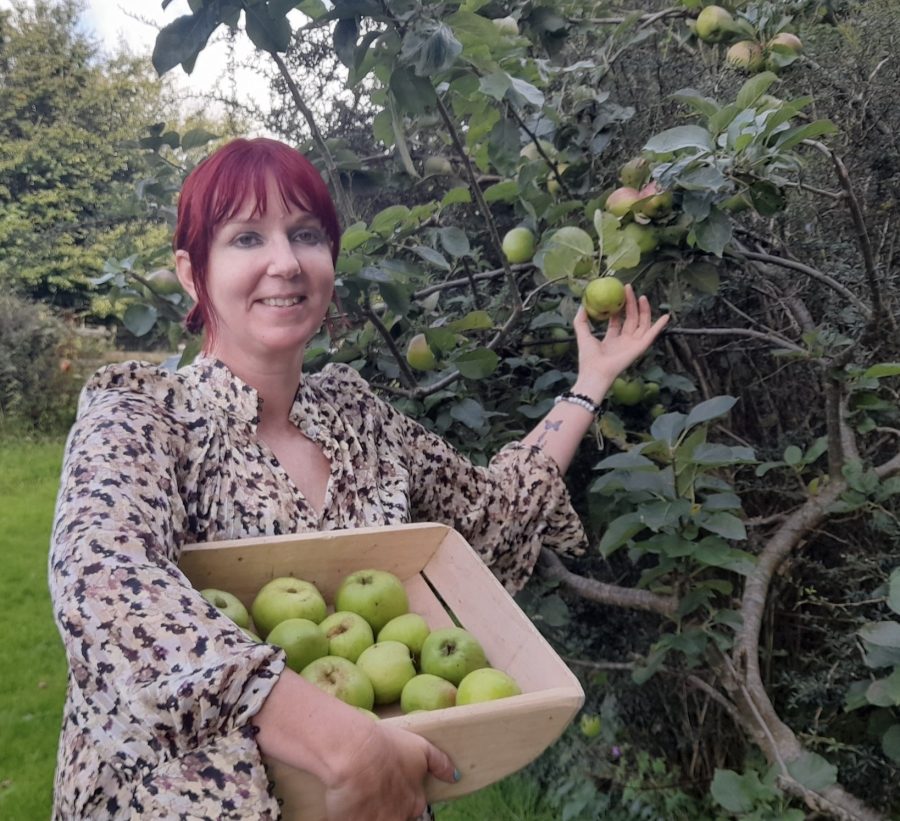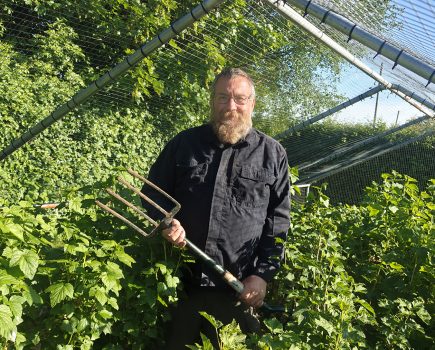Kim Stoddart (pictured above) explains how to safely save and store some of your vegetable patch harvest for the colder months ahead….
As our small holding vegetable gardens are in full productive swing, there are many ways to keep some of our produce available for longer over winter. I think it’s essential however to do so in a way that works best for you, your space and also which makes the best use of the crops you have lovingly grown.
In other words, I’d advise against saving things for the sake of it, even in a cost of living crisis. As the last thing you need is guilt next summer that you haven’t got through all last year’s frozen carrots because they are decidedly watery and bland and not much fun to eat at all. Instead let’s look out how to make the best of our homegrown bounty in ways that will enable us to feel warm and nourished inside no matter the weather.
STORING APPLES AND PEARS
This year has been absolutely fantastic for fruit, so you are likely to have a bumper harvest. Therefore I suggest a few different options to help you to enjoy these luscious fruits for longer.
Dry storage
You don’t need a dedicated apple store as containers can be improvised out of boxes, shelves or even crates. Airflow is really important and do check the information in this article on how to choose a storage space and quality control fruit, as it is especially important for apples and pears. As different varieties of fruit ripen and store for varying lengths of time, it helps to store fruit of the same type together, e.g, a box full of Cox’s Orange Pippin, so it’s easier to check on. Store fruit on a single layer so there is nothing touching, with ample airflow in-between as this helps prevent any rot from so quickly spreading.
Pears seem to ripen almost overnight and can go over rather quickly. They will therefore need more checking than your average apple store.
Keep fruit away from onions and anything strong smelling as this can negatively impact on the flavour of your lovely harvest.
Preserves and freezing
Consider using some of your apple harvest in the making of chutneys, pickles and preserves. They do make a fantastic ingredient and can also be added to jam mixes most successfully.
Additionally as any apples start to turn, consider also cooking some for pureed freezer batches as these afford you with some handy pie and crumble ingredients close to hand.
KEEPING POTATOES IN THE DARK
Main crop potato harvests can be successfully stored away till the following spring if kept in a dry, frost free, dark space. It is best to brush off earth and ensure they are fully dry before either storing in hessian sacks or trays. Do check every few weeks that there are no rotters as they can otherwise spoil your harvest.
DRY YOUR ONIONS
Bulbs need to be dried for a few weeks until they form papery skins before storing away. A popular option is the creation of an onion string, which enables your harvest to be displayed attractively as it is stored in a cooler spot in the home. Alternatively, a net bag can be used to host your onions all the while allowing the all important air flow to help bulbs store that bit longer.
GROUND THOSE BEETROOT, CARROTS,TURNIPS & SWEDE
Although you can lift crops to store them away, it’s actually logistically easier to just leave them in the ground with some additional cold weather protection. This way they can be just lifted as and when required. There is is the risk of cold and wet soil but impromptu covers can be created using materials such as horticultural fleece, sheep wool or cardboard (held in place).
Turnips benefit from being lifted by late winter but many of the other roots can successfully stand firm for accessible picking through till March of the following year. Just watch out for any signs of rodent damage. Alternatively, and if your ground is especially wet, roots can be lifted and stored in wet sand in boxes in an outbuilding or shed.
WINTER SQUASH AND PUMPKIN RIPEN ON
Fruits benefit from being left to fully ripen on the vegetable patch as long as possible but must be removed and protected before the first frosts. You can tell by looking as winter squash start to develop visible tougher skins which means they are ready for removal. If in doubt, give them a tap and a distinct hollow sound is your signal that they are ready to remove. I tend to place a brick, stone or slate underneath each fruit as it ripens to help dry them off. It is essential to keep a good few inches of stem intact with the fruit as this aids winter storage capability, so a sharp cut with secateurs can help them on their way. They then require a few weeks hardening off in the sun, so if you can leave them outside, or if the weather turns, inside in a sunny spot will also do the job nicely .Just remember they must have protection from the cold, as a frost will damage them irreparably. Storage-wise, they can be used as a feature within your home but must be kept away from direct heating. An ideal location should be no warmer than 60°F. In the right conditions they can last up to six months in storage.
Dry Storage – tips for success
Before storing away your precious produce there are some all-round quality control checks that will help ensure effective, fuss-free storage for longer.
- Make sure crops are dry: This is especially the case for anything that is to be stored in trays or bags as wet produce is much more likely to rot in storage and can further damage surrounding produce as a result. Do ensure the likes of potatoes, onions and apples and pears are moisture free.
- Check for blemishes: It is best to use any even slightly damaged crops for preserve making instead as blemished skin will make our produce more susceptible to winter rot in storage. It could also be a sign of some critter hiding within, so it’s best to err on the side of caution and make some lovely spiced jars out of it instead.
- Choose your storage space wisely: Storage needs to in a spot that is frost free so an outbuilding of some kind where you can provide extra cold weather protection if needed is ideal. If the thermostat really drops then the likes of fleece or even old blankets can be used to afford extra protection from crop spoilage. Any location should be damp free and dry; ideally it should also be well ventilated. Do also watch out for any signs of rodent activity as the blighters will move in if left unchecked and spoil your harvest in no time at all. You need a storage area out of direct sunlight and relatively dark. Don’t store produce anywhere near strong-smelling materials such as petrol, fertilisers or paint as it they will impact negatively (potentially taint) your lovely harvest. Also keep potatoes separate from apples and onions.
Kim has written books on gardening and runs courses, events and workshops. You can find out more at: www.greenrocketcourses.com
This article originally appeared in the October 2023 edition of The Country Smallholder magazine.
To receive regular copies of The Country Smallholder magazine featuring more articles like this, subscribe here.
For FREE updates from the world of smallholding, sign up for The Country Smallholder newsletter here.








